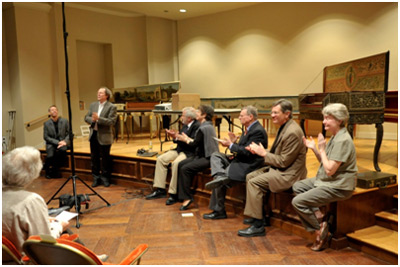- Home
- About
- About SCMS
- Directors
- Artists
- Vera Beths
- Steven Dann
- Marc Destrubé
- James Dunham
- Mark Fewer
- Eric Hoeprich
- Christopher Krueger
- Myron Lutzke
- Marilyn McDonald
- Douglas McNabney
- Mitzi Meyerson
- Pedja Muzijevic
- Anca Nicolau
- Jacques Ogg
- Loretta O'Sullivan
- Lambert Orkis
- Paolo Pandolfo
- William Purvis
- Marc Schachman
- Jaap Schröder
- Andrew Schwartz
- William Sharp
- Ian Swensen
- Lucy van Dael
- Ensembles
- Concerts
- The Collection
- Recordings
- Education
- Donate
The Smithsonian Chamber Music Society presented two special keyboard concerts toward the end of the 2009-2010 season. The weekend of Saturday/Sunday 11-12 April, harpsichordist Charles Metz brought to the Hall of Musical Instruments two instruments for comparison with instruments in the Smithsonian collection. The first was a recently-restored early 17th-century Italian pentagonal virginal attributed to the Florentine maker Francesco Poggi.

Metz discovered this instrument several years ago in a coin shop in St. Louis, and, recognizing its value, purchased it and had it restored by Walter & Berta Burr, harpsichord makers working in Hoosick, New York. The restoration was, from a musical point of view, entirely successful. The instrument’s painted decoration, executed over the original bare wood in the latter part of the 19th century, was also beautifully conserved.
The Smithsonian has a rectangular virginal from roughly the same period, also with late-nineteenth- or early-twentieth-century painted decoration, which bears an inscription declaring it to be by “Ionnes Batt. Boni da Cortona Fecit Anno 1617.”

Although the instrument is recorded in Donald Boalsch’s Makers of the Harpsichord and Clavichord 1440-1840 as being the work of Boni, recent scholarship had suggested that the probable maker was either Francesco Poggio or one of the roughly contemporary members of the Bolcioni family.
Hoping that side-by-side comparison of the Metz and Smithsonian virginals might elucidate whether the same hand had built both, curator Kenneth Slowik invited instrument makers Thomas & Barbara Wolf and Walter & Berta Burr to join him in a close examination of the two instruments.

Barbara Wolf shows one of the Boni’s split sharps, which allow enharmonically equivalent notes
(such as D-sharp and E-flat) to be tuned to different pitches
Despite finding some shared constructional details, there were enough differences to bring into question whether the noted similarities might not be ascribable to regional, rather than individual, working styles and procedures. While the attribution of the Smithsonian instrument thus must remain open, the investigation was nonetheless fascinating, as each of the participants brought his or her own ways of looking and insights to the discussion.
Metz also brought his 1981 Burr copy of the Smithsonian’s 1760 Stehlin double-manual French harpsichord, allowing the sound of the aged original instrument to be compared to the more robust younger copy and to that of another similar instrument, also by the Burrs, from 1987.

L to R: Metz at the 1760 Stehlin, the 1981 Burr copy, and the 1987 Burr copy
The weekend culminated in a public event which began with a panel discussion about the instruments, during which Metz described his first visit to the Smithsonian, as a high school student, and the thrill he had at that time at being allowed to play the Stehlin.

L to R: Metz, Slowik, and harpsichord builders Walter & Berta Burr,
Mark Adler, and Thomas & Barbara Wolf
Metz then played a recital, the first half of which consisted of 16th- and 17th-century English virginal-book music, including a substantial set of pieces by William Byrd, performed on his Poggi. After intermission, he played 18th century French works of François Couperin and Pancrace Royer on the Stehlin and the two Burr copies, joined, in several Couperin duets, by harpsichordist Webb Wiggins. After the concert, the enthusiastic audience had a chance to speak with Metz and the builders and examine the instruments at close range.

Barbara Wolf answers audience questions about the Smithsonian virginal


